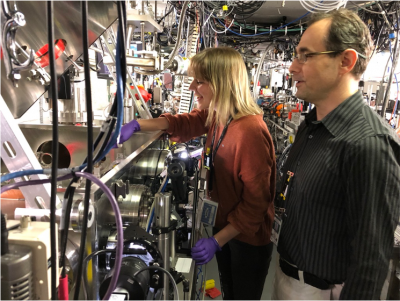Difference between revisions of "Careers ASE Irina Petrushina"
YichaoJing (Talk | contribs) (Created page with "'''Dr. Irina Petrushina, PhD 2019''' center What kind of career can a love of mathematics lead to? For Irina Pet...") |
(No difference)
|
Revision as of 16:09, 23 September 2021
Dr. Irina Petrushina, PhD 2019
What kind of career can a love of mathematics lead to? For Irina Petrushina it led to being a Research Scientist and Research Assistant Professor at Stony Brook University working on accelerator science and engineering. In high school she enjoyed languages and literature and played in the local theatre but her favorite subject by far was mathematics. This prompted her to seek education that would use a great deal of mathematics. Instead of working in pure math though she pursued career in physics as it uses mathematics to communicate the laws of nature, as she puts it.
Irina initially studied at the National Research Nuclear University, Moscow Engineering Physics Institute, where she received the M.Sc. in 2013. When she was accepted to the NRNU MEPhI she was automatically assigned to the department of charged particle beams and accelerating devices. The more she worked on the design of superconducting accelerator structures the more she became interested in the field of accelerator physics in general. Internships at the German Electron Synchrotron Laboratory DESY and Fermi National Laboratory in Illinois allowed her to work alongside renowned accelerator physicists and experience the everyday life of a real scientist. This heavily influenced her to seek a graduate education in physics which she successfully did at Stony Brook University. She received the PhD in physics in 2019.
As a Research Assistant Professor at Stony Brook University, Irina’s past and current work has focused on several aspects of accelerator physics which are of great importance to the advancement of accelerator science and medical and industrial applications of particle accelerators. She is now pursuing two substantially different, but closely intertwined aspects of modern accelerator physics: superconducting radiofrequency (SRF) photoinjectors and Laser Wake Field Accelerators (LWFA). While SRF technology remains the backbone of the so-called traditional or conventional accelerators, the rapidly evolving LWFA machines are starting to catch up to their elder siblings to produce high-brightness, high-quality beams. The overarching goal of her work is to fully explore the unique capabilities of the SRF gun, which is currently operating at nearby Brookhaven National Laboratory, and push its performance to the limit.
Irina says working in physics is exciting, you are constantly being challenged, and never get a chance to be bored. Every day you learn something new or come up with a new solution to a challenging problem, and that can be very rewarding. At the same time, she wouldn’t say that it is simple, the scientific journey can be tough from time to time, and there will be moments, when you start questioning if this hard work really pays off. But if you really enjoy the challenge, if you like solving puzzles and making things happen, she feels physics is the right place for you.
She also thinks that accelerator science is very unique in its way. Unlike the majority of disciplines in physics, there is no distinct separation between the experimental and theoretical sides. As an accelerator scientist, you get to work on a variety of aspects at the same time since it involves development of theoretical models, a variety of computer simulations, hands-on experiments, commissioning of the experimental setups and troubleshooting. Accelerator science is highly social as you get to work in a large group of physicists and engineers working towards the same goal. Asked about her most memorable parts of her education, Irina says that during her M.Sc., Prof. Ponomarenko taught a series of courses on metrology, tube amplifiers and transmission lines. She will never forget his impersonation of a dialog between a capacitor and an inductor. At Stony Brook she really enjoyed the electromagnetism lectures with Prof. Derek Teaney, Irina thinks that he is one of the most passionate professors she has ever seen. The way he builds the lectures and how actively he delivers the information is truly remarkable she says.
Finally, Irina thinks that Long Island is a beautiful place to live. She says it is very rare to be in such a close proximity to both, the ocean beaches and the most dynamic and fascinating city in the world – New York city. Long Island offers a variety of activities with its beautiful wineries, amazing beaches and scenic villages out east. She feels that if you desire more action, New York city always has numerous attractions, museums, and events, which will never disappoint.
Note: Dr. Irina Petrushina is the recipient of 2020 RHIC/AGS thesis award and also one of three physicists receiving the New York Academy of Sciences Blavatnik Award for Young Scientists.
